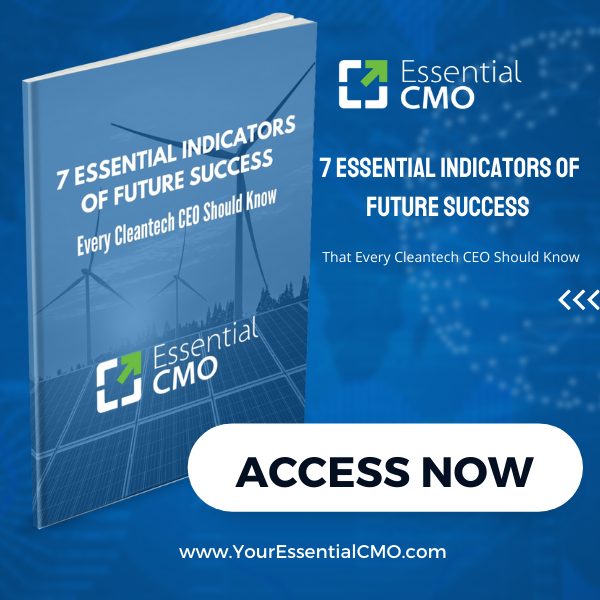“A vision without a strategy remains an illusion.”
–Author and teacher Lee Bolman
Marketing your product or services successfully requires planning. Similarly to the quote above, a plan without a strategy will fade with little or no impact. So the strategy should be on the minds of any cleantech CEO who wants to take advantage of a market growing as quickly and profoundly as renewable energy and cleantech.
When thinking about a marketing strategy (or strategies), it is easy to confuse a strategy, for a marketing plan, and even a marketing tactic. Often the terms will overlap. A strategy is the method or methods you will use to achieve a particular outcome—a marketing plan details how your marketing strategy will be implemented. Tactics are what systems, platforms, channels, operations, etc. are used to implement your developed strategy. You don’t know what tactics to use until you define your particular strategy. If tactics are implemented without an underlying strategy, there’s a bit of luck involved if you get anywhere near the results you expected or wanted.
Marketing Strategy vs. Marketing Plan
Marketing strategy is:
- It’s the “Who”, “What” and ”Why” behind your marketing efforts
- It describes how your marketing goals help your company reach its business goals
- ROI: It keeps your marketing focused and shows how to measure your results
- It details what you are offering and how you’ll deliver it, who you’ll deliver it to, who your competitors are, and how you will out-maneuver them
A marketing plan is:
- The roadmap or action plan for your strategy
- It lays out your marketing efforts, with a focus on tactics
- It’s What you will do, Where you will do it, and When you will put it in place. It’s How you track success
- It's the action plan that brings your strategy to life.
For a company to grow, it’s all about customers; finding new ones, and keeping the ones you have. To that end, your marketing strategy is the plan for reaching consumers who need what you have to offer and turning them into customers. A refined marketing strategy will include several things:
- Your company’s value proposition; what are the benefits customers will receive when they do business with you? It should be as unique to your company as possible.
- What your company has to say about itself, its ideal customer, and its unique point of view.: Key branding messages that you’ll use to engage consumers.
- Who are your customers: A strategic plan includes data about your customers, including who they are, what they like, where they can be found, and especially what their pains and challenges are.
- Product mix: A complete list of the products and/or services you plan to market and sell.
- Promotional initiatives: These are opportunities to create or increase demand for your products or services.
A marketing strategy isn’t immediately specific, rather it gives the general direction of your marketing activities.
Building a successful cleantech marketing plan may require more than one strategy. It also requires you to know as much as possible about your target customer. Doing the work and delving into the habits and expectations of a customer helps target the strategies that will do the most good for the least cost.
But what do those strategies look like? Marketing strategies evolve, just like your market. What worked 10 or 15 years ago, will not necessarily have the same impact today. And which marketing strategies do you use? It’s important to know how your customers consume information. That helps determine which strategy, and the accompanying tools will be the most effective.
You as CEO, in concert with your Chief Marketing Officer (CMO) arrive at a strategic plan and a subsequent marketing plan, you will determine what tactics to use to best meet your goals. Here are a few of the tactics your company should consider in the effort to stay competitive:
- Content Marketing
Content marketing is an online strategy that can engage customers at any point in their customer journey. Consumers of the informational content you create make better qualified leads, make buying decisions faster, and for current customers, keep them engaged until they are ready to buy again. Informational/educational content has a longer shelf life than paid media. Still, fresh content is a primary requirement, and critical to the success of this strategy. - Referral marketing, case studies, and testimonials
This area is where your customers become the sales team. Using their own positive experiences to increase your marketing efforts, A testimonial provides you with content and the customer with the recognition that their opinion about you matters. Referral marketing is a natural outgrowth of case studies and testimonials. Call it “Organized Word of Mouth” from your customers (with perhaps a little help from you). - Targeted social media campaigns
There are so many marketing opportunities in social media these days because of multiple platforms. There are just as many challenges…for the same reasons. Targeted social media uses the data-driven aspect of social media to help businesses reach the people they want to reach, Social media analytics will give you insight into where your customers are, allowing you to place your marketing efforts right in front of the right people. - Content localization
“You’re speaking my language”. This is literally and figuratively the point of this strategy: the content you provide is adapted to the culture and language of your target market. Language is just one part of it. This is a systematic way of considering as many aspects as possible to make content more accessible to that target audience. - Thought leadership
Who better to educate your customers about your industry than…you? Becoming a thought leader is just using your knowledge and expertise to build trust in customers. Thought leadership goes beyond just talking about how the widget works but allows you to discuss how the widget fits into the world and society. - Personalize your marketing messages
If time and cost were not an issue, how effective do you think it would be if you wrote a personal email and opened up a dialog with every person who showed an interest in your product or service? Marketing automation makes that possible, and infinitely easier. - Expand your multimedia efforts
Thanks to TikTok, Instagram, and YouTube, multimedia content creation has come out into the light. Explainer videos, podcasts, and video testimonials are just some of the ways to expand your multimedia content. Don’t believe that that short or quick appearance on social media by a celebrity or influencer was just on purpose. It was part of a strategic plan.
Why you need a marketing strategy
In this age of sophisticated consumers, clever competitors, and ever-changing marketing channels, a marketing strategy is essential. It helps you know your customers, where they can be found, and what they want to hear from you. But it’s not just the difference between a bad year and a good year. A recent survey suggests that businesses that employ a marketing strategy are 313% more likely to be successful.
These are just a few of the strategies and tactics that can be employed as part of a successful marketing plan. Picking which tactics to employ is ultimately up to you, but this is where your Chief Marketing Officer can advise and guide you. A vision without a strategy is an illusion. A strategy without building a solid marketing plan is a strategy to fail.
Marketing Monsoon, LLC is a growth agency specializing in lead generation, sales enablement, and customer engagement for alternative energy, healthcare technology, and staffing and HR companies. Our expertise includes strategy development, content marketing, lead generation systems, local search marketing, social media marketing, and email marketing. Get started on your strategy today by reaching out to Marketing Monsoon at (866) 851-1793.







